Recent Storm Damage Posts
Protecting Your Property from Hail Damage in Laguna Beach, CA
9/18/2024 (Permalink)
Living in Laguna Beach, CA, you might not immediately think of hail as a common threat. However, when hail does strike, it can cause significant damage. Preparing for and mitigating hail damage is helpful to protect your property and minimize repair costs. Here’s a guide on how to mitigate hail damage effectively.
Understanding the Risk
While California is not typically known for severe hailstorms, they do occur, and when they do, the damage can be extensive. According to the Insurance Information Institute, hail causes about $1 billion in damage to crops and property each year in the United States. Even if hailstorms are less frequent in Laguna Beach, the impact when they happen can still be significant.
Pre-Storm Preparation
Proper preparation can significantly reduce the damage caused by hailstorms. Here are some effective strategies to consider:
Inspect and Maintain Your Roof
One of the most effective ways to mitigate hail damage is by ensuring your roof is in good condition. Regular inspections and maintenance can prevent minor issues from becoming major problems during a hailstorm. Replace any damaged or missing shingles and consider installing impact-resistant roofing materials.
Protect Windows and Skylights
Windows and skylights are particularly vulnerable during hailstorms. Installing storm shutters or impact-resistant windows can significantly reduce the risk of breakage. For skylights, consider using wire mesh screens or clear polycarbonate covers to provide an extra layer of protection.
Secure Outdoor Equipment and Vehicles
If possible, move vehicles and outdoor equipment indoors during a hailstorm. For items that cannot be moved, cover them with thick blankets or tarps to minimize damage. This simple step can save you from expensive repairs and replacements.
During the Storm
Taking appropriate actions during a hailstorm can help minimize damage and ensure safety.
Stay Indoors and Stay Safe
During a hailstorm, the safest place is indoors, away from windows and skylights. Hailstones can shatter glass and cause injury, so ensure that everyone stays in a protected area of the building until the storm passes.
Post-Storm Actions
After the storm has passed, it's important to inspect and address any damage to your property.
Inspect Your Property for Damage
After the storm, carefully inspect your property for any signs of damage. Pay attention to the roof, windows, siding, and any outdoor equipment. Document any damage with photographs, as this will be crucial for insurance claims.
Contact Your Insurance Company
If you find significant damage, contact your insurance company immediately to start the claims process. Provide them with the documentation you gathered, including photographs and any repair estimates. According to the National Association of Insurance Commissioners (NAIC), detailed records can expedite the claims process and ensure you receive the appropriate compensation.
Hire Professional Repair Services
For extensive damage, it’s best to hire professional repair services. Attempting to fix severe damage yourself can be dangerous and may not be covered by insurance if not done correctly. SERVPRO of Laguna Beach/Dana Point is ready to help with expert storm damage restoration services and will return your home or business to its pre-storm condition quickly and efficiently.
Final Thoughts on Hail Damage Prevention
Hailstorms, while less frequent in Laguna Beach, CA, can still cause significant damage when they occur. If you need professional assistance with storm damage restoration, don’t hesitate and call SERVPRO of Laguna Beach/Dana Point. Our team is here to help you recover quickly and effectively!
Mitigating Hail Damage to Your Home or Business
5/15/2024 (Permalink)
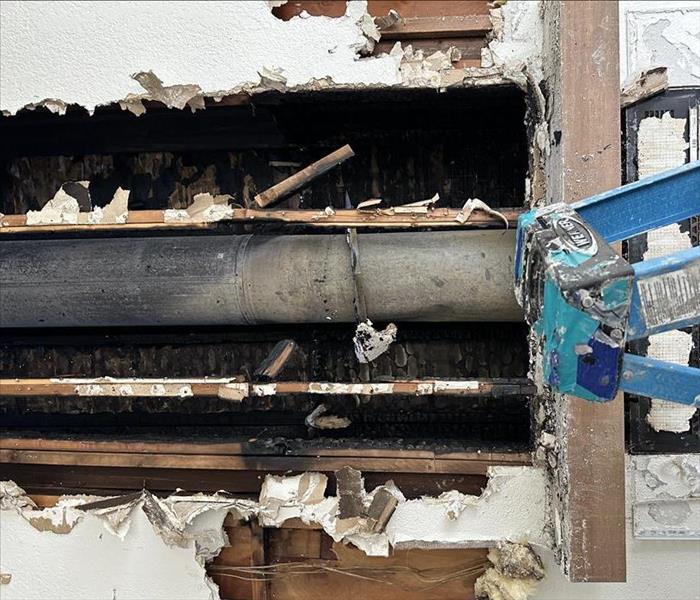 In this blog, we'll explore how to mitigate hail damage to your home or business.
In this blog, we'll explore how to mitigate hail damage to your home or business.
Hail is a type of severe weather that can cause significant damage to homes and businesses. It occurs when strong updrafts and turbulent winds within thunderstorms cause raindrops to freeze into small ice pellets that fall to the ground with considerable force. Depending on the size and density of the hailstones and the severity of the storm, hail can cause substantial damage to roofs, windows, and other parts of your home or business. In this blog, we'll explore how to mitigate hail damage to your home or business.
Check Your Insurance Coverage
Before hail season arrives, you should review your insurance coverage to understand what is included in your policy and what isn't. Understanding your coverage options can help you prepare financially for potential hail damage repairs.
Additionally, consider adding hail damage coverage to your policy if it isn't already included. This extra coverage can provide you with an added layer of protection in the event of hail damage. Be sure to consult your insurance agent and read your policy thoroughly to obtain a better understanding of your coverage options.
Inspect Your Property
It's crucial to inspect your home or business before hail season begins to identify weak spots or potential areas of damage. Pay particular attention to your roof, windows, doors, and other exterior structures that might be vulnerable to hail damage.
If you identify any issues, schedule repairs or maintenance before hail season arrives to mitigate any potential damage.
Install Protective Measures
One of the most effective ways to prevent hail damage is by installing protective measures on your property. For instance, you can install impact-resistant windows and doors to minimize hail damage.
Additionally, you can install hail-resistant roofing materials to protect your roof from hailstones. Speak with roofing companies to evaluate your options for hail-resistant materials. Hail guards or screens can also be a good solution to protect your AC unit and other exterior appliances.
Secure Outdoor Items
During hail season, it's essential to secure any loose items around your property. Secure lawn furniture, potted plants, grills, and any other loose items that can become a projectile in strong winds and hailstorms.
In addition, make sure to park your vehicles in a covered area or garage to protect them from hail damage. If you do not have a garage, use tarps to cover your car temporarily.
Repair Any Existing Damage
If your property has existing damage, such as a leaky roof or broken window, it's critical to have it repaired promptly. Hail can exacerbate existing damage, resulting in more costly repairs if left unaddressed.
Conclusion
Hailstorms are a common occurrence in many parts of the country and can cause significant damage to your property. By following these mitigation strategies, you can reduce your risk of hail damage and ensure your home or business is protected.
Inspecting your property, installing protective measures, securing outdoor items, repairing any existing damage, and checking your insurance coverage can limit the impact of hail damage on your property.
In the event that hail damage does occur, contact SERVPRO® for quick and efficient restoration services. Our team of experts has the experience, knowledge, and equipment to restore your property to its pre-damage condition and minimize the interruption to your life and your business. Don't let hail damage get you down - take the necessary steps to protect your property and contact SERVPRO if you need assistance.
SERVPRO®'s Role in Restoring Storm Damage
1/14/2024 (Permalink)
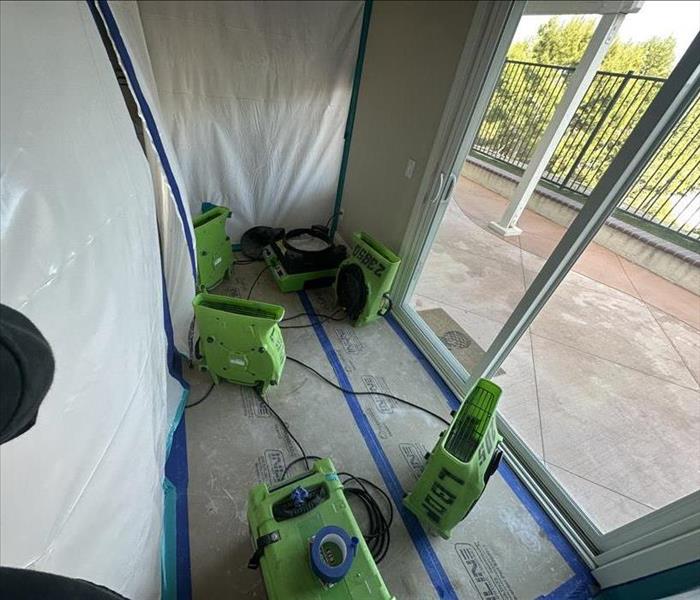 In conclusion, storms can be overwhelming, but you don't have to navigate the recovery process alone.
In conclusion, storms can be overwhelming, but you don't have to navigate the recovery process alone.
As storms wreak havoc, the aftermath often leaves homes and businesses devastated, requiring immediate attention and restoration. At SERVPRO of Laguna Beach, we understand the distress that storm damage can cause, and we're committed to quickly and efficiently restoring your home or business back to its pre-storm condition. Let's dive into the role SERVPRO® plays in storm damage recovery and how our expertise can assist in these challenging times.
Emergency Response and Assessment
When a storm strikes, our first priority is your safety. Our rapid response team promptly assesses the damage, evaluates the affected areas, and devises a comprehensive restoration plan. We employ advanced technologies to gauge the extent of damage, allowing us to create a tailored strategy for effective recovery.
2. Professional Restoration Services
Our team specializes in a wide array of storm damage restoration services. From water extraction and drying to debris removal and structural repair, our trained technicians employ industry-leading techniques and state-of-the-art equipment to expedite the restoration process.
3. Mitigation and Preventive Measures
Acting quickly is crucial to prevent further damage. Our team initiates immediate mitigation measures to safeguard your property from secondary issues like mold growth and structural deterioration. We implement thorough drying techniques, apply antimicrobial treatments, and seal vulnerable areas to prevent future issues.
4. Insurance Coordination and Documentation
Navigating insurance claims can be complex during such distressing times. SERVPRO® assists in documenting the damage, providing detailed reports, and coordinating with insurance companies to streamline the claims process for our customers. Our goal is to alleviate stress by handling the paperwork and communication, allowing you to focus on getting back to normalcy.
5. Commitment to Quality and Customer Satisfaction
At SERVPRO of Laguna Beach, we take pride in our commitment to delivering high-quality services. Our technicians undergo rigorous training and adhere to industry standards to ensure that every restoration project meets or exceeds our customers' expectations. Your satisfaction and peace of mind are our top priorities.
Why Choose SERVPRO of Laguna Beach?
- Experience: With years of experience in storm damage restoration, we have honed our expertise to efficiently handle various types and scales of damage.
- 24/7 Availability: Storms don't follow a schedule, and neither do we. Our emergency services are available 24/7, ensuring we're there when you need us the most.
- Community Involvement: As a part of the community, we understand the importance of supporting our neighbors during challenging times. We strive to be a dependable partner in recovery efforts.
In conclusion, storms can be overwhelming, but you don't have to navigate the recovery process alone. Our team stands ready to assist you in restoring your property and providing the support you need during these trying times. Contact us immediately after a storm for prompt, professional, and reliable storm damage recovery services.
How to Protect Your Electronics During Storms
9/12/2023 (Permalink)
When dark clouds gather and thunder rumbles in the distance, the safety of your home becomes a primary concern. While ensuring your physical safety during a storm is paramount, it's equally crucial to consider the protection of your valuable electronic devices. In this blog, we'll explore practical strategies and actionable tips to help you safeguard your electronics from the fury of storms. From power surges to water damage, we'll delve into the intricacies of weather-related risks and equip you with the knowledge you need to weather any storm while keeping your devices intact.
Power Surge Protection
When storms bring surges in power, your electronic devices are at risk. A reliable safeguard is investing in high-quality surge protectors. These essential devices divert excess voltage away from your electronics, preventing damage caused by sudden power spikes. Remember to use surge protectors for all your major electronic devices, including computers, televisions, gaming consoles, and home theater systems. Additionally, during severe storms, consider unplugging non-essential devices to avoid potential damage from unpredictable power surges.
Elevated Placement
Another smart approach to protect your electronics is elevating them above potential water levels. Securely mounting TVs and speakers on walls keep them out of harm's way in case of flooding. Elevate other devices on shelves or cabinets to minimize their contact with water in case of leaks. This simple yet effective tactic can go a long way in keeping your electronics safe from moisture-related damage.
Sealed Enclosures
Moisture is a common adversary of electronics, often causing irreversible damage. To combat this threat, consider using sealed containers for storing smaller electronic devices during storms. Smartphones, tablets, and other portable electronics can be safeguarded by placing them in airtight plastic bags or containers. Additionally, if you have outdoor electronics like speakers or cameras, investing in waterproof covers can offer an extra layer of protection against rain and humidity.
Surge Suppressors for Data Lines
While surge protectors are commonly associated with power cords, don't forget to extend protection to data lines as well. Ethernet and phone lines can also be vulnerable to power surges during storms. To ensure comprehensive protection, use surge suppressors designed to safeguard data lines. This extra step can prevent damage not only to your devices but also to the network they're connected to, ensuring a more secure and reliable connection.
Evacuation Plan
In the event of severe weather warnings, having an evacuation plan for your electronics can make a significant difference. Designate a safe storage area where you can quickly place your devices in sealed containers or protective coverings. Creating an electronics emergency kit is also a wise idea. Include essentials like power banks, charging cables, and portable storage devices. This kit ensures that even if you need to evacuate your home, your electronics remain protected and ready for use once the storm subsides.
Professional Inspection
Once the storm has passed, it's a good idea to consider a professional inspection to ensure your electronics are still in good condition. While you might not see immediate damage, professionals can identify hidden issues that may have occurred during the storm. They can also conduct testing to verify functionality and address any issues promptly, preventing potential long-term damage that might not be immediately evident.
Safeguard Your Electronics for a Bright Future
By implementing these strategies, you're taking proactive steps to protect your valuable electronic investments from Laguna Beach's weather. Remember, preparedness is key to ensuring your devices continue to enhance your daily life, rain or shine.
For expert advice and restoration services in the Laguna Beach area, don't hesitate to contact SERVPRO of Laguna Beach/Dana Point. We're here to help you weather the storm and keep your home and belongings safe.
How to Prepare and Protect Your Home from Earthquake Damage
6/17/2023 (Permalink)
Earthquakes are unpredictable natural disasters that can cause significant damage to homes and properties. As a homeowner, taking proactive steps to prepare for earthquakes can help minimize the potential risks and protect your property. In this blog post, we'll provide you with valuable tips on how to prepare and safeguard your home from earthquake damage, ensuring the safety of your loved ones and the longevity of your property.
Understand the Risks
Start by understanding the specific earthquake risks in your area. Research local seismic activity, fault lines, and historical earthquake data to gain insights into the potential magnitude and frequency of earthquakes in your region. This information will help you assess the level of preparedness required for your home.
Secure Heavy Furniture and Objects
During an earthquake, heavy furniture and objects can become dangerous projectiles, causing injuries and extensive damage. Secure tall furniture, bookshelves, appliances, and other heavy items to the walls or floor using brackets, straps, or anchors. This precautionary measure will prevent them from toppling over during seismic activity.
Reinforce Structural Weak Points
Identify and reinforce structural weak points in your home. Consult with a professional contractor or engineer to assess the strength of your foundation, walls, and roof. Strengthening these areas with appropriate measures like foundation bolting, adding shear walls, or retrofitting can enhance the structural integrity of your home during an earthquake.
Secure Gas and Electrical Systems
Ensure your gas and electrical systems are properly secured and protected. Consult with a licensed professional to assess and reinforce gas lines, water heaters, and electrical connections. Consider installing an automatic gas shutoff valve that activates in the event of an earthquake to prevent gas leaks and potential fires.
Create an Emergency Kit
Prepare an earthquake emergency kit that includes essential supplies such as non-perishable food, water, medications, flashlights, batteries, first aid supplies, and a battery-powered radio. Store the kit in an easily accessible location, known to all household members, to ensure quick access during an emergency.
Develop an Emergency Plan
Create an earthquake emergency plan for your family. Determine safe spots within your home, such as under sturdy furniture or against an interior wall, away from windows, mirrors, or heavy objects. Establish communication protocols, designate meeting points, and educate family members on the appropriate actions to take during and after an earthquake.
Educate Yourself and Family Members
Stay informed about earthquake preparedness and response strategies. Familiarize yourself and your family with the "Drop, Cover, and Hold On" technique, which involves dropping to the ground, taking cover under a sturdy piece of furniture, and holding on until the shaking stops. Regularly practice this technique to ensure everyone knows what to do during an earthquake.
Conduct Regular Home Maintenance
Regularly inspect and maintain your home to identify and address potential hazards. Pay attention to loose roof tiles, cracks in walls or foundations, weakened structures, and damaged utility lines. Addressing these issues promptly will reduce the vulnerability of your home to earthquake damage.
Consider Earthquake Insurance
Evaluate the need for earthquake insurance coverage for your home. Standard homeowner's insurance policies often do not include coverage for earthquake damage. Consult with your insurance provider to understand the available options and consider obtaining earthquake insurance to safeguard your investment.
Preparing and protecting your home from earthquake damage requires a proactive approach and attention to detail. By understanding the risks, securing heavy furniture, reinforcing weak points, securing gas and electrical systems, creating an emergency kit and plan, educating yourself and family members, conducting regular maintenance, and considering earthquake insurance, you can significantly reduce the potential impact of an earthquake on your home. Remember, professional assistance from a reputable disaster restoration company can provide valuable guidance and support in assessing and mitigating earthquake-related risks.
Vulnerable Areas of your Home that can be Affected After a Storm
2/13/2023 (Permalink)
It's important to know what damage can happen to your home when it's hit by strong winds or heavy rain. The most vulnerable areas of the home are generally the roof, siding, gutters and downspouts, doors and windows.
What is the most vulnerable part of a home after a storm?
Your home is made up of several parts. Each part has its own unique vulnerabilities and weaknesses, so it’s important to keep your home protected from damage. Roofing, siding and gutters protect a house from the elements outside. Doors, windows and basement or crawlspace walls keep the interior dry on the inside. Damage can occur anywhere in a home during a storm because of high winds or heavy rain that falls for hours at a time. Inspect your home quickly to help prevent secondary damages to your Laguna Beach, CA, home or business.
Roof
The roof is the most vulnerable part of your home when a storm hits, and it may be the most expensive to repair. The roof can be damaged by wind, hail, rain and snow, or even ice. It can also be damaged by falling trees or branches that are too close to the house.
If you've had a recent storm and are concerned about damage to your roof, it's important to find out what type of impact it's had on your home before making repairs.
Siding
Siding is the external covering of your house. It protects your home from the elements, and can make a big difference when it comes to resale value. Siding comes in several different types: aluminum, vinyl, cedar and redwood are among the most common.
Gutters and Downspouts
When a storm hits, it is the downspouts on your house that will most likely be damaged. Downspouts are designed to have a certain degree of flexibility, but they are not meant to withstand high winds or heavy rains. If you find that your downspouts have been damaged in a storm, contact a professional contractor immediately to repair them.
Doors and Windows
Doors and windows are the most vulnerable areas of your home. Windows are often the first to be damaged by high winds, flying debris, or flooding. When you're looking for a contractor to help you repair your windows and doors after a storm, make sure they have experience with these areas of your home.
If you're looking to make your home safer in the event of a storm, it's important to know which areas are most vulnerable. Knowing what these areas are may help you determine which ones need more attention or protection. If a storm has occurred, make sure to give the professionals a call quick at the first sign of storm damage. If your looking for a professional after a storm in your local California area, give SERVPRO of Laguna Beach a call today!
Recover Faster with a Business Continuity Plan
8/28/2022 (Permalink)
Savvy business owners in Capistrano Beach, CA, know that the unexpected can and will happen. Instead of being caught off guard, developing a business continuity plan makes it easier to weather a disaster. Whether it is flooding that requires a temporary shutdown while a water damage and restoration professional restores the building or mechanical malfunction causes an interruption, being prepared for anything makes it easier to get back on track.
Essential Elements
A continuity plan should cover three areas:
Preparedness – Determine the potential events that could impact the business and establish protocols to minimize or eliminate them.
Response – Have clear procedures in place to handle a disaster and ensure everyone’s safety.
Recovery – Know the operations critical to success and define ways to restore them.Ensuring Success
Once those three elements are made clear, executing the plan requires communication, planning and research. To ensure its success, the following are recommended:
Build a team to oversee the process. Include key members from the departments that are critical to the overall success of the company.
Take the time to identify and rank all the what-ifs. Along with the potential effects of storm damage, consider fire risks, staffing issues, supply chain interruptions and other areas that would be the most threatening to operations.
An overall analysis of critical functions should be completed. This will help business owners rank their importance and better identify department-specific processes to ensure a smoother recovery.
Ensure you have the plan written down with each procedure clearly laid out.
Since a plan is just a plan, regular tests should be done to validate strategies. Doing so will also shed light on any missed opportunities or oversights that could be detrimental in a real situation.
Although unexpected events happen, businesses don’t have to be lost in the chaos. Stay ahead of the game by developing a continuity plan to get back on track faster.
Understanding A Flood Cut In A Nutshell
7/7/2022 (Permalink)
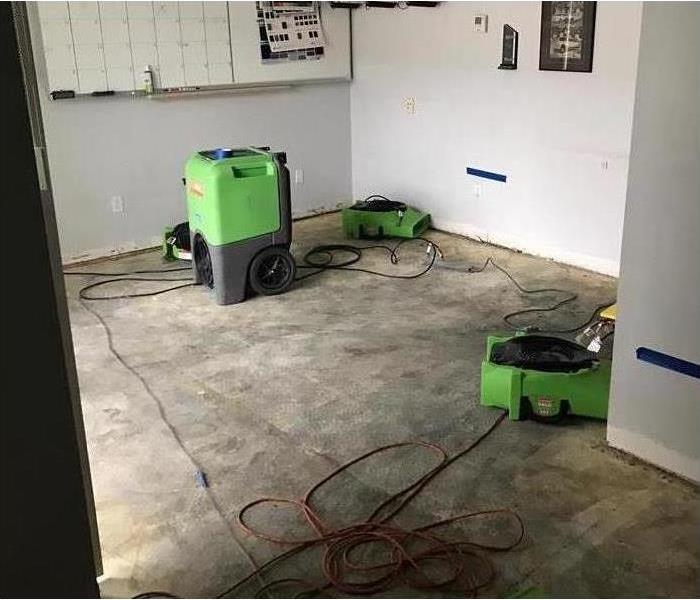 Severe floods can happen when you least expect them. The team at SERVPRO is ready to respond to any size flood in your commercial building.
Severe floods can happen when you least expect them. The team at SERVPRO is ready to respond to any size flood in your commercial building.
Understanding A Flood Cut In A Nutshell
Flooding can be a major problem for commercial buildings in Laguna Beach, CA. It can lead to structural damage, mold growth, and sewage contamination. In certain cases, your flood cleanup company may start talking to you about doing a flood cut. This term may sound daunting, but it is a simple procedure that can help speed up the remediation process for your building. Learn more about this process to figure out if it is right for your flood remediation project.
What Is It?
Simply put, a flood cut is the removal of drywall in a flooded building. If the contractor has to tear out drywall, he or she will make a cut 12 to 18 inches above the flood line. Any drywall below that line is removed from the wall.
When Is It Necessary?
This restoration procedure isn't always necessary. You may have to have it done in your building if any of the following is true:
- The wall is insulated.
- The water is contaminated.
- There is potential mold growth in the wall.
If the flooding involves only clean water, there is a greater chance that you won't have to have any of your drywall taken out.
How Does It Help?
Removing the bottom portion of the drywall allows the interior of the wall to dry out faster. It also allows the restoration experts to visually see what's going on. They may be able to see signs of mold growth or other issues. Drywall is a porous material, so it often soaks up a lot of water. If the floods in your commercial building included any black water, removing the drywall helps remove all signs of contamination from the structure.
When your Laguna Beach, CA, building is affected by flooding, you want the issue to be addressed as quickly and efficiently as possible. Tearing out most of the lower drywall may seem counterintuitive, but it can actually help speed up your building's restoration.
Can You Flood-Proof Your Home?
6/10/2022 (Permalink)
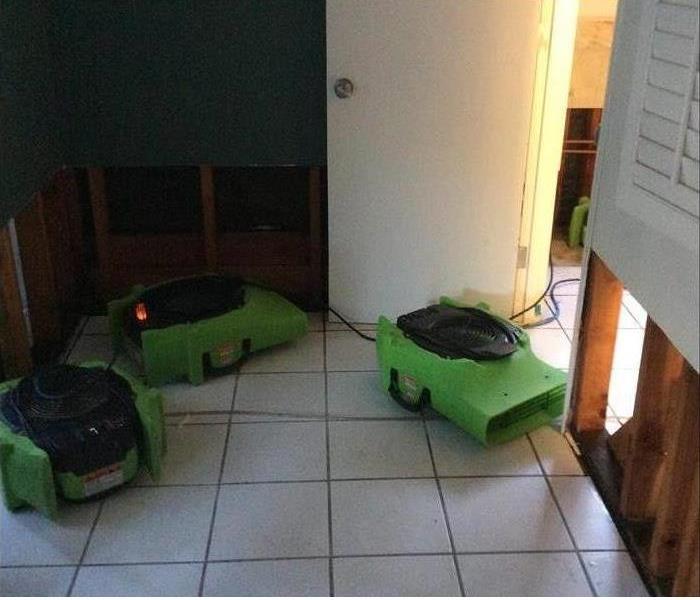 SERVPRO can respond immediately to your home or business after a severe storm. Call us when you need it!
SERVPRO can respond immediately to your home or business after a severe storm. Call us when you need it!
Is Your House Flood-Proof?
Short of buying a home that sits on the top of a hill in the middle of a desert, the best way to protect your home from flooding is to develop a good flood safety plan. Here are four safety tips you can follow to minimize costly damage to your home.
1. Elevate Your Home
If you are buying a home, check FEMA’s website to find out how high local rivers and lakes are expected to rise during a severe storm. If possible, buy a home above the flood line. If you are buying a home on a beach, you can elevate your home by setting it on piers or columns.
2. Elevate Electrical Systems
For maximum flood safety, you must ensure that electrical systems are not on ground level. Safety tips include elevating electrical wires, breakers, sockets and outlets at least 1 foot off the ground. Air conditioners, furnaces and water heaters should be elevated and secured. Generators must be installed above the flood line or else they can become damaged, useless, and possibly dangerous during a flood.
3. Protect Sewer Systems
During a flood, backed-up and overflowing sewer systems can cause unsanitary conditions that spread disease. Flood-proof your sewer system by installing backflow valves on all pipes that enter your home.
4. Make a Last-Minute Effort
If flooding is imminent, some last-minute efforts can help minimize damage to your home in Laguna Beach, CA. Clean gutters to help route the water away from your home. Try to get kitchen appliances off the ground. Move valuables upstairs or onto countertops to minimize losses.
With a little planning, you can minimize the damage your home experiences during a flood. If flood damage occurs, enlist the help of a professional storm damage restoration company to return your home to its pre-flood condition. Remember to always watch and adhere to any flood safety or evacuation warnings.
3 Flood Prevention Tips for the Proactive Business Owner
4/18/2022 (Permalink)
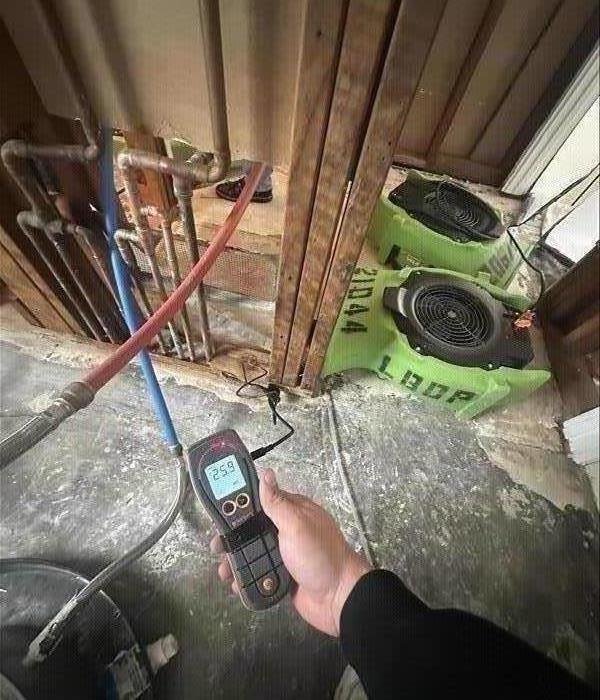 Floods cause billions of dollars in damage, leaving business owners left to deal with flood cleaning.
Floods cause billions of dollars in damage, leaving business owners left to deal with flood cleaning.
Three Flood Prevention Tips For The Forward-Thinking Business Owner
According to National Geographic, floods are the most common and destructive natural disaster. Whether it's from melting snow, a broken levee or a severe thunderstorm, floods cause billions of dollars in damage, leaving business owners left to deal with flood cleaning. Being proactive is key to protecting your property, but it can feel overwhelming. Here are three flood prevention tips to consider before the next big storm rolls in.
1. Inspect the Building Regularly
Regular assessments of your building and its surroundings are one of the best ways to avoid flood damage altogether. An inspection can reveal areas that are susceptible to water damage, and it can highlight opportunities for repairs and flood-proofing. Pay close attention to basements and other low-lying areas, and take care of any repairs in a timely fashion.
2. Clean the Roof and Gutters
Before a storm rolls through Lantern Village, CA, take some time to clean gutters, downspouts, and other drainage areas. These mechanisms are less effective for flood prevention when they're full of leaves and other matter. Keeping these areas clear will ensure that water doesn't back up into the building after heavy rain.
3. Manage the Landscape
Floodwaters move quickly, and many business owners don't realize the effect that landscaping has. Designs such as rain gardens or swales can help collect and redirect rainwater. Whatever you do, make sure the landscaping is designed so that water runs away from the property. If there's significant work to be done, hire a professional who can help design and implement a water damage prevention strategy for your building's exterior.
Being proactive about flood prevention can save you the headache of dealing with water damage on your commercial property. Maintaining your building's interior and exterior through regular inspections and cleanup is the easiest way to keep your building dry all year round. If your building has already been impacted by water damage, a flood cleanup company can assess the water damage and identify a solution.
Roof Repair: Factors Affecting Insurance Coverage
3/24/2022 (Permalink)
Insurance Coverage For Roof Repairs: What Factors Affect It
When many homeowners think about storm coverage, they usually think about flood protection. Your home in Dana Point, CA, can just as easily suffer wind damage, though. Flying items can break windows and cause holes in your roof. There are several factors that affect whether your homeowner’s insurance covers damage to your roof and, if so, how much it covers.
Prevention Measures
Most insurance companies want to make sure the damage listed on your claim was indeed caused by wind and not the neglect of routine maintenance. There are several steps you can take to increase the likelihood that the damage will be covered:
- Quarterly professional inspection
- Impact-resistant shingles
- Regular maintenance and repair
- Proper landscaping to minimize debris during a storm
Being able to show that you have taken the appropriate precautions to minimize roof damage in the event of a storm improves your chances of being covered by your policy.
Documentation
One of the first calls you will make after wind damage occurs is to your insurance company. An adjuster will come assess the damage detailed in your claim. You probably want storm mitigation experts to start repairs before the adjuster arrives, however, to prevent further issues. It’s important to take pictures or videos of the original damage and to list all the repairs that need to be done. Document everything you list in your claim.
Value of Roof
As parts of your home age, they depreciate in value. If your roof is more than ten years old, the insurance company may not foot the entire bill, especially if you need total roof replacement. You may get partial coverage for its current value. Even if the roof is newer, the insurance company may not pay the full cost of repairs or replacement if it was significantly worn before the most current damage happened.
The best way to know how much of the wind damage repairs your insurance company will cover is to ask. Your agent can detail the factors involved in making decisions about claims.
Beyond Routines: 4 Tools to Prevent Basement Flooding and Backups
1/13/2022 (Permalink)
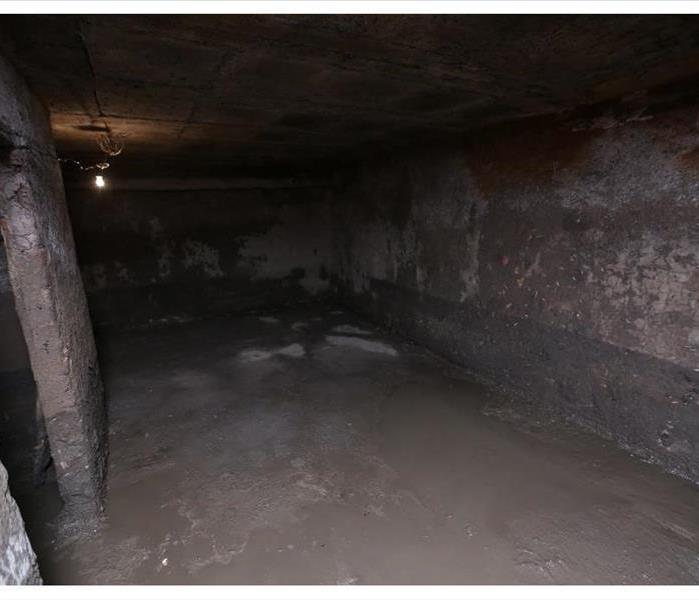 When you find flooding in your home after a storm, be sure to call the trained experts at SERVPRO for mitigation services.
When you find flooding in your home after a storm, be sure to call the trained experts at SERVPRO for mitigation services.
4 Tools To Prevent Basement Flooding And Backups Beyond Routines
A sewer backup can cost thousands to repair and remedy. In Laguna Beach, CA, regulations and even insurance policies may require a contract with an emergency restoration company due to the contamination of black water and the subsequent health risks. Fortunately, there are several steps you can take to prevent this type of flooding.
• Regular Sewer Cleaning
• Biannual Inspections
• Routine Debris Removal
Beyond these basic routines, there at least four tools you can install as preventative measures.
1. Backwater Valve
Requiring a licensed plumber for installation, a backwater valve is installed at the exterior of the building and connects to the waste line. The valve allows sewage to exit a property, but it closes and blocks sewage from backing up into the home.
2. Standpipe
A standpipe is just as it sounds. It is a pipe that stands a minimum of 3 feet out of a drain and is sealed around the base. When a backup occurs, the water rises in the pipe but does not spill out onto the floor, unless the flood is especially deep. A standpipe does not require professional installation.
3. Overhead Sewer
Another tool requiring professional installation, the overhead sewer works in conjunction with a sump pump to eliminate the risk of storm damage due to flooding. In this system, the sump pump forces water into overhead pipes that are connected into the wastewater lines, where the water flows out and away from the home.
4. One-Way Drain
A one-way drain is the simplest of all the preventative measures. This tool uses a floating mechanism to block the drain, preventing backflow. If water begins backing up, the float seals the floor drain. When water subsides, and pressure normalizes, the float lowers and allows for normal drainage.
A sewer backup can cause a significant amount of damage and can leave homeowners scrambling for solutions in a reactionary way. Fortunately, there are numerous ways to be proactive about this type of dilemma. While routine maintenance and inspections are excellent ways to ensure functionality, the four tools above offer the ability to prevent significant damage when all else fails.





 24/7 Emergency Service
24/7 Emergency Service


